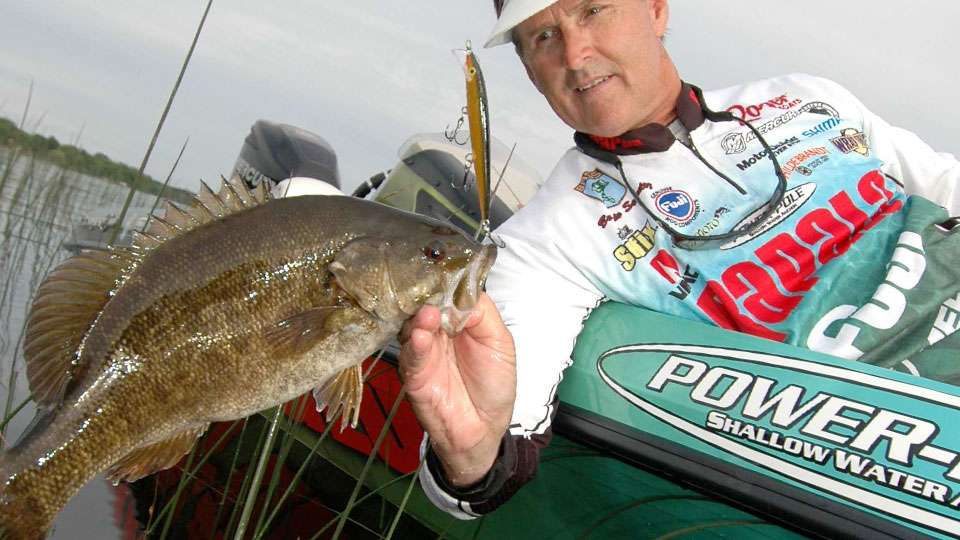
Oklahoman Edwin Evers shocked the bass community in 2015 when he won a midsummer Bassmaster Elite Series tournament on New York’s St. Lawrence River by catching hefty smallmouth bass as shallow as 2 feet deep. Aren’t the brown ones supposed to be lurking in the dark depths in July and August?
During the previous Elite Series tournament on the St. Lawrence in 2013 many of the heaviest smallmouth limits were caught 30 feet deep and deeper. Deep bass were present when Evers won, but they were not as plentiful as in the 2013 event. He credits a full moon for keeping more of the smallmouth in the shallows.
Florida Elite Series pro Bernie Schultz agrees that more smallmouth were shallow when Evers won. However, Schultz claims that in northern waters like the St. Lawrence, Lake Champlain and Lake St. Clair, there are always enough shallow smallmouth to fare well in a tournament.
Schultz finished 15th in the St. Lawrence event that Evers won. He finished sixth at the 2013 Elite tournament there. He caught his bass shallow at both events.
“I’ve made checks at just about every northern smallmouth tournament I’ve fished in the summertime,” Schultz said. “I always fish shallow, and I have a lot of water to myself.”
Under normal midsummer conditions, there are far more smallmouth bass in deep water than in the shallows, Schultz conceded. His shallow strategy consists of covering a lot of water and targeting fewer scattered bass.
Cast here
“The key is having shallow water adjacent to deep water,” Schultz said. “Twenty to 30 feet would be great.”
The shallow feeding area could be a shoal, reef, point or sandbar. If there is vegetation present, it is typically pencil reeds. Since shallow smallmouth tend to be here today and gone tomorrow, it is imperative that you have a milk run. The more shallow feeding locations you hit the better your odds for piecing together a substantial limit.
Shallow tactics
Most of the lures in Schultz’s extensive shallow water arsenal are moving baits that draw the bass up.
“In clear northern lakes it’s important to keep your bait over their heads,” Schultz said.
A Hildebrandt Drum Roller originally designed for redfish, is one of Schultz’s primary shallow water smallmouth baits. He dresses the hook with a 4-inch, Z-Man Laminate Swimmerz swimbait.
His other lures include small swimbaits and topwater plugs, including Rapala’s Skitter V and Storm’s Arashi Cover Pop. Add to this hard jerkbaits and soft stickbaits.
“Once I find some fish I’ll slow down with a tube or drop shot,” Schultz said. “I’ve caught smallmouth on a drop shot in less than 2 feet of water.”

Sight fishing
After Evers won the Elite tournament on the St. Lawrence, he mentioned that he saw many smallmouth in the shallows before he caught them. Although these were not bedding bass, he was sight fishing for them.
Seth Feider, the Minnesota smallmouth ace who is currently an Elite Series pro, often sight fishes for summertime smallmouth in shallow water.
“For me, the shallow bite is all about conditions,” Feider said. “I need a calm, sunny day to go shallow in the middle of the summer. It’s just the opposite of what you would think.”
These conditions allow Feider to see smallmouth bass in 2 to 6 feet of water. He pointed out that northern smallmouth bass often feed in the shallows during the summer because the water never gets too warm for them.
Feider looks for the bass on shallow humps and reefs. He runs his electric motor on high speed and keeps the sun at his back so he can better see into the water. When smallmouth frequent the shallows on sunny days, their color darkens, which makes them easier to spot, Feider added.
“There’s not much chance to see them before they see you,” Feider said. “But you can spook them and still catch them. I cast as far ahead of them as I can and bring the bait back to them.”
Two lures do the heavy lifting for Feider. One is a popper. He swoons about Storm’s Arashi Cover Pop, which he works with a bloop-bloop action and also as a walking bait.
“That’s the best popper I’ve ever seen,” Feider said. “It walks so good I hardly throw a Spook anymore.”
His other go-to bait is a bitsy 3/32-ounce marabou jig he designed for Outcast Tackle dubbed the Feider Fly. To give the bantamweight jig greater casting distance, Feider dresses the hook with a 1/2–inch length of plastic he cuts from a Senko.
To get the distance needed to cast the light jig ahead of a cruising smallmouth, Feider claimed it is essential to use spinning tackle with gossamer 6-pound Suffix 832 braid and an 8-pound Suffix Fluorocarbon leader. He matches the line to a soft 7-foot, 6-inch, Daiwa Tatula rod and a 3000 size Daiwa reel. The long rod and the reel’s large diameter spool also increase distance.
“I’m casting to individuals,” Feider said. “They’re pretty catchable because they’re cruising around looking for food. I’ve chased some fish 100 yards before catching them.”





